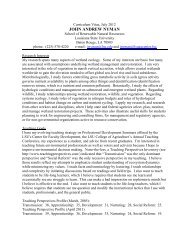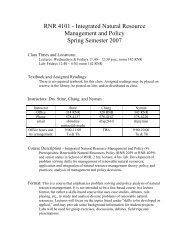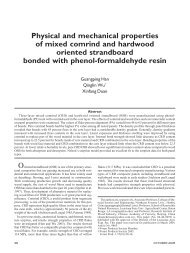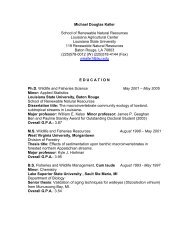Composite Materials Journal of Thermoplastic - LSU School of ...
Composite Materials Journal of Thermoplastic - LSU School of ...
Composite Materials Journal of Thermoplastic - LSU School of ...
You also want an ePaper? Increase the reach of your titles
YUMPU automatically turns print PDFs into web optimized ePapers that Google loves.
218 S.-Y. LEE ET AL.<br />
This result could be due to an improved interfacial adhesion between the<br />
polymer matrix and fillers.<br />
Neat PLA had the highest H c (34.1 J/g) and X c (44.5%) values<br />
compared to PLA/WF composites. The H c decreased as the loading<br />
level <strong>of</strong> WF increased (Figure 4(a)). Obviously, this result could be<br />
attributed to the amount <strong>of</strong> PLA in the composites as the WF content<br />
increased. The application <strong>of</strong> 10 wt% talc to PLA/WF composites further<br />
decreased the H c . The large decrease in the X c <strong>of</strong> the composites with the<br />
addition <strong>of</strong> WF, talc and silane was observed in Figure 4(b). This may be<br />
caused by the partial inhibition effect <strong>of</strong> WF, talc and silane on polymer<br />
crystal formation.<br />
Mechanical Properties<br />
The tensile modulus <strong>of</strong> neat PLA was 1,346 MPa (Figure 5(a)). As WF<br />
levels increased, the tensile modulus was enhanced. With the WF loading<br />
levels increased from 10 to 40 wt%, the tensile modulus increased from 62.5 to<br />
169.5%. The tensile strength <strong>of</strong> neat PLA was 63 MPa (Figure 5(b)). For<br />
PLA/WF composites, the tensile strength increased 13.7, and 16.7, and 13.9%<br />
at the loading levels <strong>of</strong> 10, 20, and 30 wt% WF, respectively. At 40 wt% WF<br />
loading, PLA/WF composite had a similar tensile strength as the neat PLA.<br />
As shown in Figure 5(a), the addition <strong>of</strong> talc (10 wt%) to PLA/WF<br />
composites improved the tensile modulus by about 18.3 to 50.2%.<br />
In addition, the use <strong>of</strong> 1 and 3 wt% silane led to the higher tensile modulus<br />
<strong>of</strong> composites, compared to neat PLA and PLA/WF composites without<br />
silane treatment. As shown in Figure 5(b), the addition <strong>of</strong> talc (10 wt%) to<br />
PLA/WF composites resulted in a slightly lower tensile strength than neat<br />
PLA. At 10 wt% talc loading, the tensile strength slightly decreased as the<br />
WF level increased. The PLA50%/WF40%/talc10% composite showed an<br />
8.6% lower tensile strength than the PLA80%/WF10%/talc10% composite.<br />
In addition, PLA50%/WF40%/talc10% composite had a 10.7% lower<br />
tensile strength than neat PLA. The addition <strong>of</strong> 1 wt% silane to PLA/WF/<br />
talc composites improved the tensile strength considerably, which indicates<br />
that silane facilitates the chemical bonding between WF and PLA, and<br />
between inorganic filler and PLA. The tensile strength <strong>of</strong> PLA/WF/talc<br />
composites with 1 wt% silane was significantly greater than that <strong>of</strong> PLA/<br />
WF/talc composites with 3 wt% silane. As discussed earlier, the addition <strong>of</strong><br />
1 wt% silane was more effective to improve interfacial adhesion than the<br />
addition <strong>of</strong> 3 wt% silane. An improved interfacial adhesion could be<br />
explained by a mechanism shown in the following three steps;<br />
1st step: the formation <strong>of</strong> silanol (Si-OH) by hydrolysis, or R-Si-<br />
(OH) 3 þ MeOH.<br />
Downloaded from http://jtc.sagepub.com at KAIST GRADUATE SCHOOL OF MGMT on April 27, 2008<br />
© 2008 SAGE Publications. All rights reserved. Not for commercial use or unauthorized distribution.
















